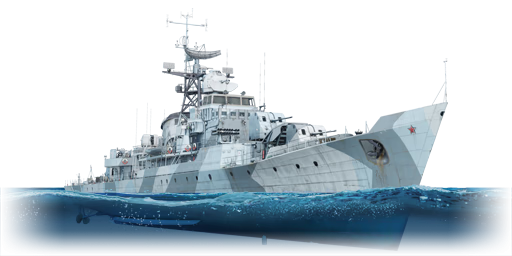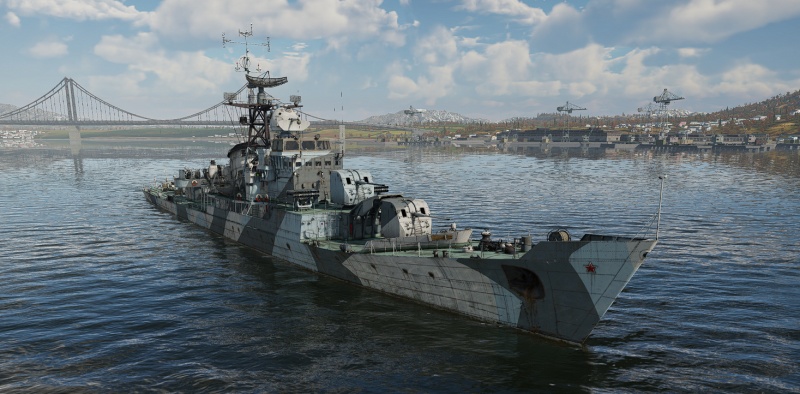Rosomacha
Contents
Description
The Pr.50, SKR Rosomacha is a premium rank IV Soviet frigate with a battle rating of 4.0 (AB/RB/SB). It was introduced in Update "Ixwa Strike".
General info
Survivability and armour
Talk about the vehicle's armour. Note the most well-defended and most vulnerable zones, e.g. the ammo magazine. Evaluate the composition of components and assemblies responsible for movement and manoeuvrability. Evaluate the survivability of the primary and secondary armaments separately. Don't forget to mention the size of the crew, which plays an important role in fleet mechanics. Save tips on preserving survivability for the "Usage in battles" section. If necessary, use a graphical template to show the most well-protected or most vulnerable points in the armour.
Mobility
Write about the ship's mobility. Evaluate its power and manoeuvrability, rudder rerouting speed, stopping speed at full tilt, with its maximum forward and reverse speed.
| Mobility Characteristics | |||
|---|---|---|---|
| Game Mode | Upgrade Status | Maximum Speed (km/h) | |
| Forward | Reverse | ||
| AB | |||
| Upgraded | 77 | 27 | |
| RB/SB | |||
| Upgraded | 55 | 20 | |
Modifications and economy
Armament
Primary armament
Provide information about the characteristics of the primary armament. Evaluate their efficacy in battle based on their reload speed, ballistics and the capacity of their shells. Add a link to the main article about the weapon: {{main|Weapon name (calibre)}}. Broadly describe the ammunition available for the primary armament, and provide recommendations on how to use it and which ammunition to choose.
| Penetration statistics | |||||||
|---|---|---|---|---|---|---|---|
| Ammunition | Type of warhead |
Penetration @ 0° Angle of Attack (mm) | |||||
| 100 m | 1,000 m | 2,000 m | 3,000 m | 4,000 m | 5,000 m | ||
| F-56 HE | HE | 24 | 24 | 24 | 24 | 24 | 24 |
| ZS-56 HE | HE-TF | 24 | 24 | 24 | 24 | 24 | 24 |
| ZS-56R HE-VT | HE-VT | 16 | 16 | 16 | 16 | 16 | 16 |
| Shell details | ||||||||||||
|---|---|---|---|---|---|---|---|---|---|---|---|---|
| Ammunition | Type of warhead |
Velocity (m/s) |
Projectile mass (kg) |
Fuse delay (m) |
Fuse sensitivity (mm) |
Explosive mass (TNT equivalent) (kg) |
Ricochet | |||||
| 0% | 50% | 100% | ||||||||||
| F-56 HE | HE | 900 | 15.8 | 0 | 0.1 | 1.93 | 79° | 80° | 81° | |||
| ZS-56 HE | HE-TF | 900 | 15.6 | 0 | 0.1 | 1.93 | 79° | 80° | 81° | |||
| Proximity-fused shell details | ||||||||||||
|---|---|---|---|---|---|---|---|---|---|---|---|---|
| Ammunition | Type of warhead |
Velocity (m/s) |
Projectile mass (kg) |
Fuse delay (m) |
Fuse sensitivity (mm) |
Arming distance (m) |
Trigger radius (m) |
Explosive mass (TNT equivalent) (kg) |
Ricochet | |||
| 0% | 50% | 100% | ||||||||||
| ZS-56R HE-VT | HE-VT | 900 | 15.9 | 0 | 0.1 | 270 | 15 | 1.23 | 79° | 80° | 81° | |
Secondary armament
Some ships are fitted with weapons of various calibres. Secondary armaments are defined as weapons chosen with the control Select secondary weapon. Evaluate the secondary armaments and give advice on how to use them. Describe the ammunition available for the secondary armament. Provide recommendations on how to use them and which ammunition to choose. Remember that any anti-air armament, even heavy calibre weapons, belong in the next section. If there is no secondary armament, remove this section.
- Universal: HEF-T · AP-T · HEF-T · HEF-T · AP-T
- 37 mm HE clips: HEF-T · HEF-T · HEF-T · HEF-T · AP-T
- 37 mm AP clips: AP-T · AP-T · AP-T · AP-T · HEF-T
| Penetration statistics | |||||||
|---|---|---|---|---|---|---|---|
| Ammunition | Penetration @ 0° Angle of Attack (mm) | ||||||
| 10 m | 100 m | 500 m | 1,000 m | 1,500 m | 2,000 m | ||
| HEF-T | 3 | 3 | 3 | 3 | 3 | 3 | |
| AP-T | 79 | 76 | 63 | 51 | 41 | 32 | |
| Shell details | ||||||||||||
|---|---|---|---|---|---|---|---|---|---|---|---|---|
| Ammunition | Velocity (m/s) |
Projectile mass (kg) |
Fuse delay (m) |
Fuse sensitivity (mm) |
Explosive mass (TNT equivalent) (g) |
Ricochet | ||||||
| 0% | 50% | 100% | ||||||||||
| HEF-T | 880 | 0.72 | 0 | 0.1 | 56.98 | 79° | 80° | 81° | ||||
| AP-T | 880 | 0.76 | - | - | - | 47° | 60° | 65° | ||||
Anti-aircraft armament
An important part of the ship's armament responsible for air defence. Anti-aircraft armament is defined by the weapon chosen with the control Select anti-aircraft weapons. Talk about the ship's anti-air cannons and machine guns, the number of guns and their positions, their effective range, and about their overall effectiveness – including against surface targets. If there are no anti-aircraft armaments, remove this section.
Additional armament
Describe the available additional armaments of the ship: depth charges, mines, torpedoes. Talk about their positions, available ammunition and launch features such as dead zones of torpedoes. If there is no additional armament, remove this section.
Usage in battles
Describe the technique of using this ship, the characteristics of her use in a team and tips on strategy. Abstain from writing an entire guide – don't try to provide a single point of view, but give the reader food for thought. Talk about the most dangerous opponents for this vehicle and provide recommendations on fighting them. If necessary, note the specifics of playing with this vehicle in various modes (AB, RB, SB).
Pros and cons
Summarise and briefly evaluate the vehicle in terms of its characteristics and combat effectiveness. Mark its pros and cons in the bulleted list. Try not to use more than 6 points for each of the characteristics. Avoid using categorical definitions such as "bad", "good" and the like - use substitutions with softer forms such as "inadequate" and "effective".
Pros:
Cons:
History
The Project 50 frigate, NATO reporting name Riga-class, was a class of frigates built for the Soviet Navy in the 1950s. The Soviet designation for these ships was Storozhevoi Korabl (escort ship) Project 50 Gornostay (Ermine stoat). The Riga class was analogous to World War II era destroyer escorts.
These ships were a smaller and simpler version of the Kola class frigate. According to Conway's, this simpler group of ships were ordered by Joseph Stalin who was concerned about the cost of large ships. The class introduced high pressure steam turbines and new radars into Soviet service. The bridge, gun turrets, and magazines were covered in 8 mm (0.31 in)-thick armour. The main armament comprised three single dual-purpose 100 mm (3.9 in) guns with remote power control and a single Yakor type fire control director. The machinery comprised two TV-9 steam turbines with two boilers and had initial problems with reliability.
The Project 50 Riga class was a rather simplistic and straight forward design. With their basic capabilities, moderate size and ease of operation, they made perfect export vessels for smaller navies where such ships could easily fill the multi-purpose role, taking the place of large minesweepers and actual destroyers.
There was a modernisation programme designated Project 50 A in the late 1950s early 1960s. This included fitting anti-submarine rocket launchers (RBU-2500) new radar and adding permanent ballast for improved stability.[1]
Media
- Skins
See also
- Related development
External links
Paste links to sources and external resources, such as:
- topic on the official game forum;
- other literature.
| Yantar Baltic Shipyard (Прибалтийский судостроительный завод «Янтарь») | |
|---|---|
| Frigates | |
| Project 50 | Yenot · Rosomacha · Karl Marx* |
| Project 35 | SKR-7 |
| *Tur in East German service | |
| USSR frigates | |
|---|---|
| Pr. 50 | Rosomacha · Yenot |
| Pr. 159 | SKR-1 |
| Pr. 35 | SKR-7 |
| Pr. 1331M | MPK Pr.1331M |
| USSR premium ships | |
|---|---|
| Motor torpedo boats | G-5 (ShVAK) · Pr.123K (A-10bis) |
| Motor gun boats | TKA-412 · Pr.183 BM-21 · Ya-5M |
| Motor torpedo gun boats | MPK Pr.12412P |
| Armoured gun boats | MBK-161 early · MBK pr.186 (MK 85) · Pr.1124 MLRS · Pr.1204 |
| Sub-chasers | MPK Pr.122bis |
| Frigates | Rosomacha |
| Destroyers | Kerch · Ryany · Leningrad · Stroyny · Smelyi · Neustrashimy · Blagorodnyy |
| Light cruisers | Murmansk · Kerch · Zheleznyakov |
| Battleships | Marat |





